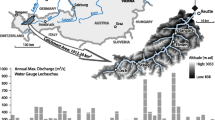Abstract
This paper estimates property loss and business interruption loss under scenarios of storm surge inundation to explore the economic impact of climate change on Ise Bay, Japan. Scenarios-based analyses are conducted with respect to Typhoon Vera, which caused the most severe storm surge in the recorded history of Japan in 1959. Four different hazard scenarios are chosen from a series of typhoon storm surge inundation simulations: Typhoon Vera’s landfall with respect to the condition of the past seawall; Typhoon Vera’s landfall with respect to the condition of the current seawall; intensifying Typhoon Vera, but retaining its original tracks; and intensifying Typhoon Vera, but choosing the worst tracks from various possible typhoon tracks. Our economic loss estimation takes advantage of fine geographical scale census and economic census data that enable us to understand the spatial distribution of property loss and business interruption loss as well as identify the most potentially affected areas and business sectors on a sub-city scale. By comparing the property loss and business interruption loss caused by different hazard scenarios, the effect of different seawalls is evaluated and the economic impact of future climate change is estimated. The results indicate that although the current seawall can considerably reduce the scale of losses, climate change can cause Ise Bay to experience more serious storm surge inundation. Moreover, the resulting economic losses would increase significantly owing to a combination of climate change and the worst track scenario. It is, therefore, necessary to consider more countermeasures to adapt to climate change in this area.








Similar content being viewed by others
References
Hunt A, Watkiss P (2011) Climate change impacts and adaptation in cities: a review of the literature. Clim Change 104(1):13–49
Intergovernmental Panel on Climate Change (2014) Climate change 2013: the physical science basis: working group I contribution to the fifth assessment report of the intergovernmental panel on climate change. Cambridge University Press, Cambridge
Kim SY, Yasuda T, Mase H (2008) Numerical analysis of effects of tidal variations on storm surges and waves. Appl Ocean Res 30(4):311–322
Kirshen P, Ruth M, Anderson W (2008) Interdependencies of urban climate change impacts and adaptation strategies: a case study of Metropolitan Boston USA. Clim Change 86(1–2):105–122
Kousky C (2012) Informing climate adaptation: a review of the economic costs of natural disasters, their determinants, and risk reduction options. Resources for the Future Discussion Paper, 2012 (12–28)
Ministry of Land, Infrastructure and Transport (2005) Manual of economic survey for water management (In Japanese)
Mitsuta Y, Fujii T (1986) Analysis of the typhoon pressure patterns over Japanese Islands. Nat Disaster Sci 8(2):19–28
Mori N (2012) Projection of future tropical cyclone characteristics based on statistical model. Cyclones Formation, Triggers and Control, Nova Science Publishers, Inc., 24 p
Myers VA, Malkin W (1961) Some properties of hurricane wind fields as deduced from trajectories. In: National Hurricane Research Reports No. 49, U.S. Weather Bureau, Washington, DC, pp 1–45
Nicholls RJ (2004) Coastal flooding and wetland loss in the 21st century: changes under the SRES climate and socio-economic scenarios. Glob Environ Change 14(1):69–86
Pinto JG, Fröhlich EL, Leckebusch GC, Ulbrich U (2007) Changing European storm loss potentials under modified climate conditions according to ensemble simulations of the ECHAM5/MPI-OM1 GCM. Nat Hazards Earth Syst Sci 7(1):165–175
Rosenzweig C, Solecki WD (2001a) Climate change and a global city: the metropolitan east coast regional assessment. Columbia Earth Institute, New York, p 24
Rosenzweig C, Solecki WD (2001b) Global environmental change and a global city: lessons for New York. Environment 43(3):8–18
Shibutani Y, Kim SY, Yasuda T, Mori N, Mase H (2014) Sensitivity of future tropical cyclone changes to storm surge and inundation: Case Study in Ise Bay Japan. Coast Eng Proc. doi:10.9753/icce.v34.management.27
Sinfonica (2006) Establishment and enterprise census of Japan (in Japanese)
Sinfonica (2009) Areal mesh based economy census of Japan (in Japanese)
Sinfonica (2010) Areal mesh based census of Japan (in Japanese)
Statistics Bureau, Ministry of Internal Affairs and Communications, Japan (2009) A Guide to the Statistics Bureau, the Director-General for Policy Planning (Statistical Standards) and the Statistical Research and Training Institute
Tatano H, Tsuchiya S (2008) A framework for economic loss estimation due to seismic transportation network disruption: a spatial computable general equilibrium approach. Nat Hazards 44(2):253–265
Tol RSJ (2002) Estimates of the damage costs of climate change. Part 1: Benchmark estimates. Environ Resour Econ 21(1):47–73
Warner NN, Tissot PE (2012) Storm flooding sensitivity to sea level rise for Galveston Bay, Texas. Ocean Eng 44:23–32
Yamano N, Kajitani Y, Shumuta Y (2007) Modeling the regional economic loss of natural disasters: the search for economic hotspots. Econ Syst Res 19(2):163–181
Yang L, Tatano H, Kajitani Y, Jiang X (2015) A case study on estimation of business interruption losses to industrial sectors due to flood disasters. J Disaster Res 10(5):981–990
Yasuda T, Kim SY, Mase H, Mori N, Horsburgh K (2014) Evaluation of future storm surge risk in East Asia based on state-of-the-art climate change projection. Coast Eng 83:65–71
Acknowledgments
This work was supported under the framework of the “Precise Impact Assessments on Climate Change” of the Program for Risk Information on Climate Change (SOUSEI Program) supported by the Ministry of Education, Culture, Sports, Science, and Technology-Japan (MEXT) and Grand-in-aid by KAKENHI.
Author information
Authors and Affiliations
Corresponding author
Rights and permissions
About this article
Cite this article
Jiang, X., Mori, N., Tatano, H. et al. Estimation of property loss and business interruption loss caused by storm surge inundation due to climate change: a case of Typhoon Vera revisit. Nat Hazards 84 (Suppl 1), 35–49 (2016). https://doi.org/10.1007/s11069-015-2085-z
Received:
Accepted:
Published:
Issue Date:
DOI: https://doi.org/10.1007/s11069-015-2085-z




